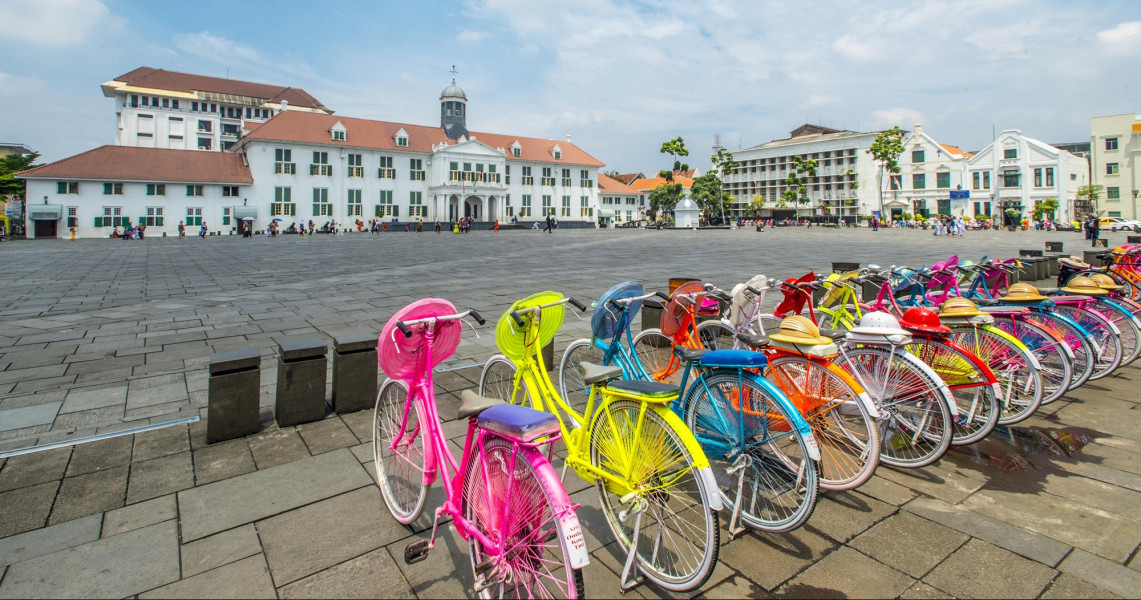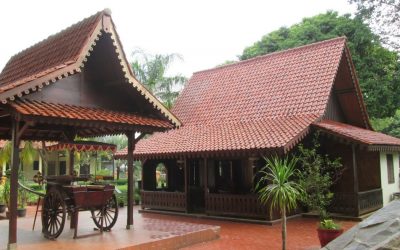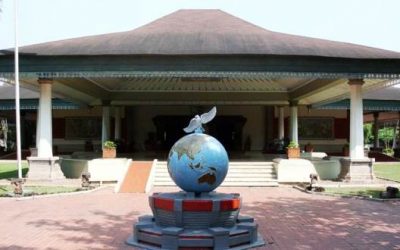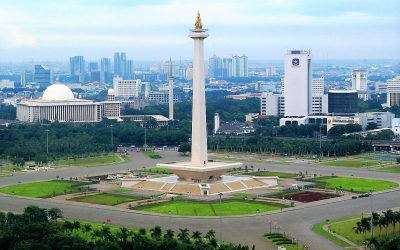Home / Batik Regions – Western Indonesia – Java Island – Jakarta / Kota Tua – Jakarta Old Town
Cultural Destination
Kota Tua – Jakarta Old Town

The Jakarta Old Town (photo: @Pesona.Travel)
Kota Tua – Jakarta Old Town
This ancient trading community was the seed of Jakarta as the capital city. It is the biggest Chinatown area in Jakarta, and it hosts a lot of historical and cultural occurrences even since before the time of the Dutch occupation. As the name already suggests, there are many historical buildings that were built in the colonialism era that are still standing. You can rent vintage bicycle at a museum and visit other museums next to it. There are also many cosy restaurants in this place that serve authentic Chinese-Jakarta culinary delights, as well as unique vintage photo gallery exhibitions.
Tourist Attractions in Jakarta
Setu Babakan – Betawi Cultural Village
This place will make you know and appreciate some cultural heritage of
Indonesian Stamp Museum
This quaint museum will bring you back to in time, to when smartphones and
National monument – The Monas
The monument was a “lighthouse project” designed to remind
Jakarta
Batik Motifs
Discover
Indonesian
Batik
Motifs
Singayaksa
The Singayaksa motif comes from the name of a place where Sultan Hasanuddin used to
Srimanganti
The name of the Srimanganti motif is derived from Palace’s hallway that connects to
Bale Lumbu
This motif signifies the welfare of the ancient Sasak society. Bale also symbolizes the
Sandeq
Sandeq Boat is a symbol of the maritime importance of the West Sulawesi region. The greatness of
Lipaq Sabe
Lipaq Saqbe contains a simple geometric classical motif with various flower decorations. This textile is
Pucuk Rebung Riau
Pucuk Rebung symbolizes heart determination in achieving goals, good luck, and
Kawung
The Kawung motif was created by Sultan Agung Hanyokrokusumo (1593 – 1645) as a symbolic gift for
Sekomandi
Its philosophical meaning is the eternal union which refers to a saying “until death do us part”
Salakanagara
Salakanagara batik motif illustrates the first kingdom in the Betawi land
Bekantan Pakis
This motif represents Pakis Haji (Polystichum setiferum), an endemic plant in
Keluak Daun Pakis
The word “Keluak” is a Minang language which means twisted or tangled. The Motif of
Manguni Minahasa
Manguni is identified as the symbol of the Minahasa people. Manguni is known as a
Pala Salawaku
This motif illustrates the unique weapons of the Maluku region, namely
Pohon Hayat (Tree of Life)
The Batik motifs in Lampung are dominated by the acculturation of Buddhist and
Pinawetengan
The Pinawetengan Batik pattern was taken from a prehistoric inscription in
Leuit Sijimat
This motif reflects the daily activities of the Baduy tribe in Banten. The main ornaments of batik motif consist of:
Dayak Taghol
Dayak Taghol has a distinctive style of four curved lines and small dots. This motif represents
Besurek Rembulan
This batik illustrates praise for God who created the wonderful universe
Gonggong Siput
Gonggong (Strombus Turturella) is one type of sea snail found around
Sero Tangga
The Sero Tangga illustrates an endearing feeling and sacrifices of a person to fulfil
Gurdo Solo
Gurdo or garuda bird is the mount of the Indian god Vishnu. As the Sun Bird,
Ikan tambal
The word “Ikan” refers to fish. The philosophical meaning of Ikan Tambal means is
Mahkota Siger
Siger is the crown of a noblewoman in ancient time. It is a symbol of femininity, strength, and
Enggang Dayak
Local people beliefs that hornbills are an incarnation of the Commander of the Birds. It has supernatural
Ukir Sentani
The Ukir motif is a batik motif that is inspired by various traditional Sentani wood carvings
Raja Ampat
Raja Ampat motif represents the marine life at Raja Ampat archipelago in
Jupri Kembang Teh
Kembang Teh illustrates the tendrils of tea plants that grow in the highlands of
Taiganja
Taiganja is a precious gold pendant that shows the social status of the Kaili family. It is
Gentala Arasy
Built as high as 80 meters, the tower also highlights the historical side of
Bomba Mawar
This motif means sacred love for family, kingdom, and God; It also illustrates
Wakatobi
It symbolizes the coastal beauty of the Wakatobi island and the symbol of Patra symbolizes
Gajah Way Kambas
The motif illustrates the Lampung’s natural reserve, the Way Kambas. it also symbolizes
Kaganga Tanah Rejang
If Batik Besurek combines Arabic calligraphy motifs, then the Kaganga batik takes
Dayak Kamang
Kamang motif is generally found in the Dayak tribe shield because it is believed to
Daun Simpor
This motif is inspired by the Simpor plant (Dillenia Suffruticosa) which is a typical
Daun Sirih
This motif illustrates betel leaves that are used by Lombok communities as traditional
Karawo Pinang
Pinang refers to the Palm areca tree. This motif is considered as the original
Sekar Jati
Sekar means flower and Jati refers to teak trees that symbolizes a strong mental character that
Durian Pecah
Broken Durian motifs depict the foundation of faith. The second half signifies the mastery of
Wirasat
Wirasat or divine inspiration is a gift from God. This inspiration is symbolized by
Bintik Tujuh
The Bintik Tujuh (Seven Dots) motif has 7 white spots and green color gradation as
Parang Rusak
Another meaning behind this motif is an unconquerable spirit, symbolized by
Tongkonan
Toraja’s traditional house is called Tongkonan. Tongkonan is a place for
Awan Berarak
Awan Berarak is a combination of Dayak motifs and Malay patterns. The word ‘Awan Berarak’ means the
Insang Ikan
Insang refers to the gills of the fish. This is a typical pattern of Malay ethnic who inhabits
Ake Patra
Ake is related to the divinity and the composition of the universe. It is a symbol of
Honai
The Honai is inspired by the traditional house of the Papuan community living in
Jumputan Bintang
The word Jumputan means the tie-dye technique, while the word “Bintang” refers to
Gigi Haruan Lidi
The Gigi Haruan Lidi motif is taken from the name of the cork fish and is a symbol of
Parang Seling
Parang Seling or “alternating daggers” is a royal batik motif. It is a feminine variant of
Gamolan
This motif illustrates Gamolan, a bamboo musical instrument of Lampung that is
Daun Lada Hitam
The black pepper motif represents the main commodity of Bangka Belitung
Karawo Mahkuta
Mahkuta refers to Gorontalo’s traditional crown. It represents noble characters of
Gorga Simeol-Meol
The Gorga Simeol-meol is a pattern of plant tendrils. it is regarded as a symbol of longevity and
Merak Ngeram
The hatching peacock motif has a very deep meaning which refers to the sacrifice and
Tabir Tanjung
Tanjung flower is a type of Cherry tree flower, which is commonly found in
Bultiya
The word ‘Bultiya’ is an acronym of the three major tribes in North Kalimantan, namely
Burung Bidadari
Bidadari birds are endemic birds in Halmahera. This motif represents an
Tampuk Manggis Sasirangan
The motif illustrates the philosophy of the mangosteen fruit, which is
Hiu Taliyasan
Indonesia is also home to the world’s largest fish, the whale shark (Rhincodon typus). Hiu Taliyasan refers to
Rumah Mamuju
the Batik motif illustrates the house of Mamuju King with the stairs, located on the left of the wooden stage house
Tubo Kelapa
Coconut tree is a symbol of a good character and strong mentality. It illustrates the more success a person, the more
Tengkawang Ampiek
With its many advantages, the Dayaks use this leaf in ritual ceremonies. This plant is a symbol of
Gonggong Beruntun
This motif illustrates that a person should maintain a positive attitude and
Malinau Cultural Festival
You will witness a unique competition that might not be found other than in
Tifa Totobuang
The batik motifs illustrate Maluku’s traditional music instrument called
Kasih Tak Sampai
‘Kasih Tak Sampai’ is an idiom in the Indonesian language which refers to
Sido Mulyo
Sidomulyo is one of the classical motifs, which is specifically used for the bride’s costume in
Kuda Kupang
Horses symbolize wealth. It contains noble values of virtuous characters that bring
Kerawang Tegak Aceh
The Vertical Upright (Kerawang Tegak) Motif symbolizes a person who has a strong
Tenun Bima
The motifs are adopted from Bima woven textile. This pattern has received a great
Lok Baintan Floating Market
As you can imagine, the most authentic thing is that you can buy things and even



